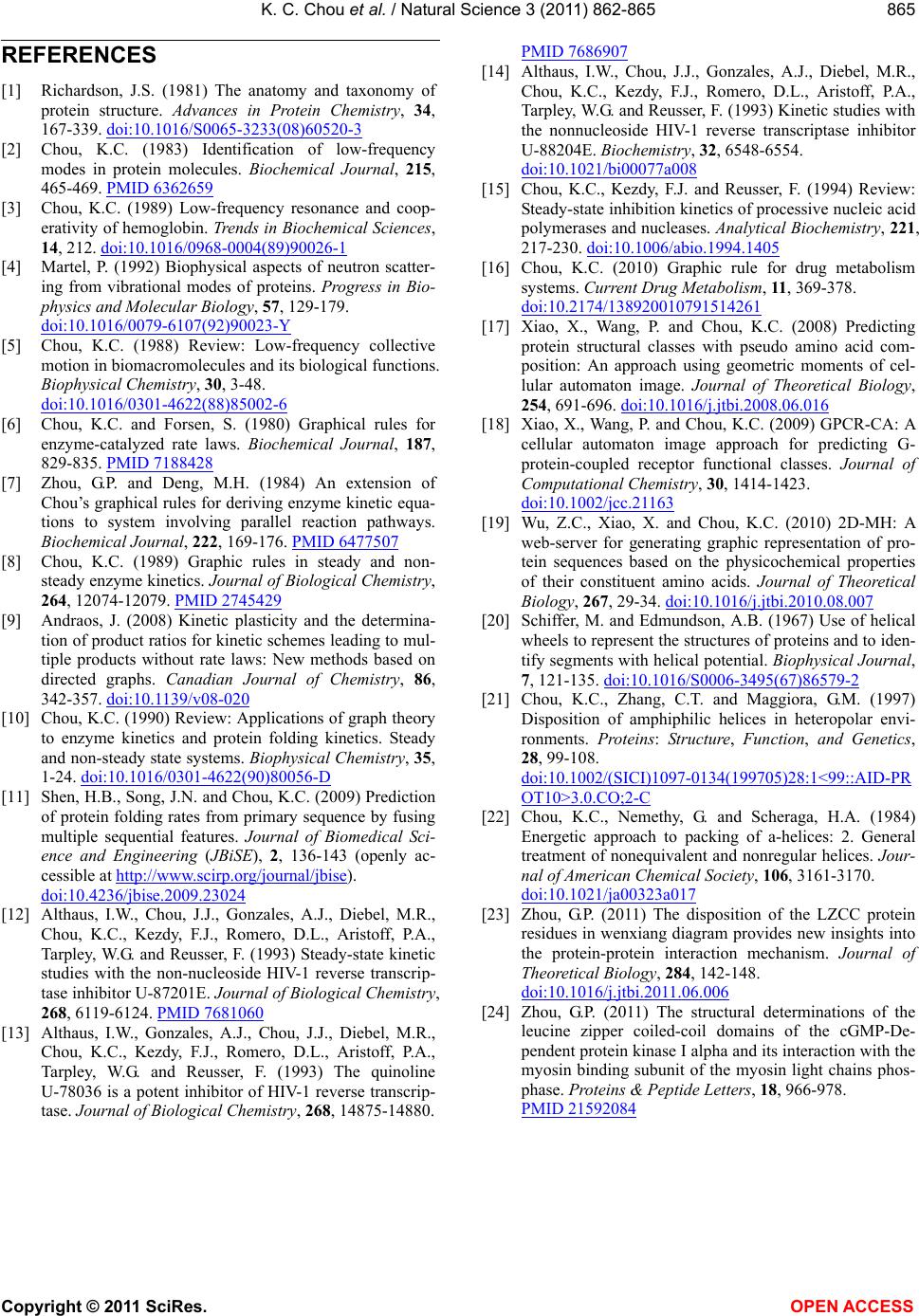
K. C. Chou et al. / Natural Science 3 (2011) 862-865
Copyright © 2011 SciRes. OPEN ACCESS
865
865
REFERENCES
[1] Richardson, J.S. (1981) The anatomy and taxonomy of
protein structure. Advances in Protein Chemistry, 34,
167-339. doi:10.1016/S0065-3233(08)60520-3
[2] Chou, K.C. (1983) Identification of low-frequency
modes in protein molecules. Biochemical Journal, 215,
465-469. PMID 6362659
[3] Chou, K.C. (1989) Low-frequency resonance and coop-
erativity of hemoglobin. Trends in Biochemical Sciences,
14, 212. doi:10.1016/0968-0004(89)90026-1
[4] Martel, P. (1992) Biophysical aspects of neutron scatter-
ing from vibrational modes of proteins. Progress in Bio-
physics and Molecular Biology, 57, 129-179.
doi:10.1016/0079-6107(92)90023-Y
[5] Chou, K.C. (1988) Review: Low-frequency collective
motion in biomacromolecules and its biological functions.
Biophysical Chemistry, 30, 3-48.
doi:10.1016/0301-4622(88)85002-6
[6] Chou, K.C. and Forsen, S. (1980) Graphical rules for
enzyme-catalyzed rate laws. Biochemical Journal, 187,
829-835. PMID 7188428
[7] Zhou, G.P. and Deng, M.H. (1984) An extension of
Chou’s graphical rules for deriving enzyme kinetic equa-
tions to system involving parallel reaction pathways.
Biochemical Journal, 222, 169-176. PMID 6477507
[8] Chou, K.C. (1989) Graphic rules in steady and non-
steady enzyme kinetics. Journal of Biological Chemistry,
264, 12074-12079. PMID 2745429
[9] Andraos, J. (2008) Kinetic plasticity and the determina-
tion of product ratios for kinetic schemes leading to mul-
tiple products without rate laws: New methods based on
directed graphs. Canadian Journal of Chemistry, 86,
342-357. doi:10.1139/v08-020
[10] Chou, K.C. (1990) Review: Applications of graph theory
to enzyme kinetics and protein folding kinetics. Steady
and non-steady state systems. Biophysical Chemistry, 35,
1-24. doi:10.1016/0301-4622(90)80056-D
[11] Shen, H.B., Song, J.N. and Chou, K.C. (2009) Prediction
of protein folding rates from primary sequence by fusing
multiple sequential features. Journal of Biomedical Sci-
ence and Engineering (JBiSE), 2, 136-143 (openly ac-
cessible at http://www.scirp.org/journal/jbise).
doi:10.4236/jbise.2009.23024
[12] Althaus, I.W., Chou, J.J., Gonzales, A.J., Diebel, M.R.,
Chou, K.C., Kezdy, F.J., Romero, D.L., Aristoff, P.A.,
Tarpley, W.G. and Reusser, F. (1993) Steady-state kinetic
studies with the non-nucleoside HIV-1 reverse transcrip-
tase inhibitor U-87201E. Journal of Biological Chemistry,
268, 6119-6124. PMID 7681060
[13] Althaus, I.W., Gonzales, A.J., Chou, J.J., Diebel, M.R.,
Chou, K.C., Kezdy, F.J., Romero, D.L., Aristoff, P.A.,
Tarpley, W.G. and Reusser, F. (1993) The quinoline
U-78036 is a potent inhibitor of HIV-1 reverse transcrip-
tase. Journal of Biological Chemistry, 268, 14875-14880.
PMID 7686907
[14] Althaus, I.W., Chou, J.J., Gonzales, A.J., Diebel, M.R.,
Chou, K.C., Kezdy, F.J., Romero, D.L., Aristoff, P.A.,
Tarpley, W.G. and Reusser, F. (1993) Kinetic studies with
the nonnucleoside HIV-1 reverse transcriptase inhibitor
U-88204E. Biochemistry, 32, 6548-6554.
doi:10.1021/bi00077a008
[15] Chou, K.C., Kezdy, F.J. and Reusser, F. (1994) Review:
Steady-state inhibition kinetics of processive nucleic acid
polymerases and nucleases. Analytical Biochemistry, 221,
217-230. doi:10.1006/abio.1994.1405
[16] Chou, K.C. (2010) Graphic rule for drug metabolism
systems. Current Drug Metabolism, 11, 369-378.
doi:10.2174/138920010791514261
[17] Xiao, X., Wang, P. and Chou, K.C. (2008) Predicting
protein structural classes with pseudo amino acid com-
position: An approach using geometric moments of cel-
lular automaton image. Journal of Theoretical Biology,
254, 691-696. doi:10.1016/j.jtbi.2008.06.016
[18] Xiao, X., Wang, P. and Chou, K.C. (2009) GPCR-CA: A
cellular automaton image approach for predicting G-
protein-coupled receptor functional classes. Journal of
Computational Chemistry, 30, 1414-1423.
doi:10.1002/jcc.21163
[19] Wu, Z.C., Xiao, X. and Chou, K.C. (2010) 2D-MH: A
web-server for generating graphic representation of pro-
tein sequences based on the physicochemical properties
of their constituent amino acids. Journal of Theoretical
Biology, 267, 29-34. doi:10.1016/j.jtbi.2010.08.007
[20] Schiffer, M. and Edmundson, A.B. (1967) Use of helical
wheels to represent the structures of proteins and to iden-
tify segments with helical potential. Biophysical Journal,
7, 121-135. doi:10.1016/S0006-3495(67)86579-2
[21] Chou, K.C., Zhang, C.T. and Maggiora, G.M. (1997)
Disposition of amphiphilic helices in heteropolar envi-
ronments. Proteins: Structure, Function, and Genetics,
28, 99-108.
doi:10.1002/(SICI)1097-0134(199705)28:1<99::AID-PR
OT10>3.0.CO;2-C
[22] Chou, K.C., Nemethy, G. and Scheraga, H.A. (1984)
Energetic approach to packing of a-helices: 2. General
treatment of nonequivalent and nonregular helices. Jour-
nal of American Chemical Society, 106, 3161-3170.
doi:10.1021/ja00323a017
[23] Zhou, G.P. (2011) The disposition of the LZCC protein
residues in wenxiang diagram provides new insights into
the protein-protein interaction mechanism. Journal of
Theoretical Biology, 284, 142-148.
doi:10.1016/j.jtbi.2011.06.006
[24] Zhou, G.P. (2011) The structural determinations of the
leucine zipper coiled-coil domains of the cGMP-De-
pendent protein kinase I alpha and its interaction with the
myosin binding subunit of the myosin light chains phos-
phase. Proteins & Peptide Letters, 18, 966-978.
PMID 21592084